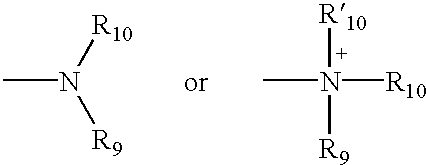4,4-Disubstitued piperidines, and methods of use thereof
a technology of piperidines and substituents, applied in the field of4,4-disubstituted piperidines, can solve the problems of limited number of compounds that can be synthesized, limited choice of reagents and conditions that can be employed for the synthesis of non-oligomeric libraries, and desensitization of receptors or ion channels
- Summary
- Abstract
- Description
- Claims
- Application Information
AI Technical Summary
Problems solved by technology
Method used
Image
Examples
example 2
4-Dimethylcarbamoyl-4-phenyl-piperidine-1-carboxylic Acid Tert-butyl Ester
[0291] 16
[0292] A 250 mL round-bottom flask was charged with acid (6.1 g; 20 mmol), PyBOP (10.4 g; 20 mmol), DMF (100 mL) and NMM (4.4 mL; 40 mmol). The reaction mixture was stirred at 20.degree. C. for 15 min and then DMAP (240 mg; 2.0 mmol) and Me.sub.2NH (12.0 mL; 60.0 mmol) was added. The reaction mixture was stirred at 20.degree. C. for 12 h. The reaction mixture was diluted with 1:1 MTBE / EtOAc (250 mL). The organic was washed with H.sub.2O (250 mL), saturated NaCl (250 mL), dried with MgSO.sub.4, filtered and concentrated in vacuo. The crude material was purified by flash chromatography (silica gel hexanes / THF 3:1) to yield pure product (6.0 g; 90% yield). .sup.1H-NMR (300 MHz) .delta. (ppm) 7.20-7.40 (m; 5H), 3.98 (d; 2H); 3.23 (t; 2H); 2.40-3.00 (bs; 6H); 2.35 (d; 2H); 1.90 (t; 2H); 1.40 (s; 9H). .sup.13C-NMR (300 MHz) .delta. (ppm) 174.1; 155.3; 145.0; 129.3; 128.8; 127.0; 125.2; 79.6; 49.8; 41.6; 38....
example 3
4-Phenyl-piperidine-4-carboxylic Acid Dimethylamide
[0293] 17
[0294] A 100 mL round-bottom flask was charged with Boc-protected piperidine (2.0 g; 6.0 mmol) and 50 mL of a 1:1 mixture of TFA and CH.sub.2Cl.sub.2. The reaction mixture was stirred for 1 h and then concentrated in vacuo. The crude material was used without further purification. .sup.1H-NMR (300 MHz) .delta. (ppm) 10.61 (s, 3H); 7.90 (bs; 1H); 7.20-7.45 (m, 5H); 3.52 (s; 3H); 3.02 (s; 2H); 2.60 (m; 4 H); 2.25 (m; 2H). .sup.13C-NMR (300 MHz) .delta. (ppm) 174.6; 141.8; 130.1; 128.4; 124.6; 48.5; 42.8; 39.1; 38.4; 32.2.
example 4
4-Hydroxymethyl-4-phenyl-piperidine-1-carboxylic Acid Benzyl Ester
[0295] 18
[0296] A 500 mL round-bottom flask was charged with acid (25 g; 66.0 mmol), K.sub.2CO.sub.3 (13.7 g; 99.0 mmol), CbzCl (15.9 g; 79.0 mmol), THF (125 mL) and H.sub.2O (125 mL). The reaction mixture was stirred at 20.degree. C. for 12 h. The reaction mixture was adjusted to pH=4 with 10% HCl and extracted with EtOAc (250 mL). The organic was dried with MgSO.sub.4 filtered and concentrated in vacuo to give pure product (15.9 g; 71% yield). .sup.1H-NMR (300 MHz) .delta. (ppm) 7.25-7.40 (m; 10H); 5.18 (s; 2H); 4.05 (m; 2H); 3.21 (m; 2H); 2.55 (m; 2H); 1.95 (m; 2H).
PUM
| Property | Measurement | Unit |
|---|---|---|
| diameter | aaaaa | aaaaa |
| diameter | aaaaa | aaaaa |
| diameter | aaaaa | aaaaa |
Abstract
Description
Claims
Application Information
 Login to View More
Login to View More - R&D
- Intellectual Property
- Life Sciences
- Materials
- Tech Scout
- Unparalleled Data Quality
- Higher Quality Content
- 60% Fewer Hallucinations
Browse by: Latest US Patents, China's latest patents, Technical Efficacy Thesaurus, Application Domain, Technology Topic, Popular Technical Reports.
© 2025 PatSnap. All rights reserved.Legal|Privacy policy|Modern Slavery Act Transparency Statement|Sitemap|About US| Contact US: help@patsnap.com



